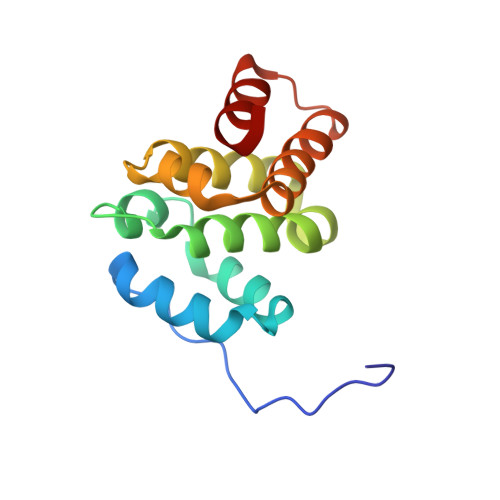The RPAP3-Cterminal domain identifies R2TP-like quaternary chaperones.
Maurizy, C., Quinternet, M., Abel, Y., Verheggen, C., Santo, P.E., Bourguet, M., C F Paiva, A., Bragantini, B., Chagot, M.E., Robert, M.C., Abeza, C., Fabre, P., Fort, P., Vandermoere, F., M F Sousa, P., Rain, J.C., Charpentier, B., Cianferani, S., Bandeiras, T.M., Pradet-Balade, B., Manival, X., Bertrand, E.(2018) Nat Commun 9: 2093-2093
- PubMed: 29844425
- DOI: https://doi.org/10.1038/s41467-018-04431-1
- Primary Citation of Related Structures:
6EZ4 - PubMed Abstract:
R2TP is an HSP90 co-chaperone that assembles important macro-molecular machineries. It is composed of an RPAP3-PIH1D1 heterodimer, which binds the two essential AAA+ATPases RUVBL1/RUVBL2. Here, we resolve the structure of the conserved C-terminal domain of RPAP3, and we show that it directly binds RUVBL1/RUVBL2 hexamers. The human genome encodes two other proteins bearing RPAP3-C-terminal-like domains and three containing PIH-like domains. Systematic interaction analyses show that one RPAP3-like protein, SPAG1, binds PIH1D2 and RUVBL1/2 to form an R2TP-like complex termed R2SP. This co-chaperone is enriched in testis and among 68 of the potential clients identified, some are expressed in testis and others are ubiquitous. One substrate is liprin-α2, which organizes large signaling complexes. Remarkably, R2SP is required for liprin-α2 expression and for the assembly of liprin-α2 complexes, indicating that R2SP functions in quaternary protein folding. Effects are stronger at 32 °C, suggesting that R2SP could help compensating the lower temperate of testis.
- IGMM, CNRS, Université de Montpellier, Montpellier, 34293, France.
Organizational Affiliation:
















